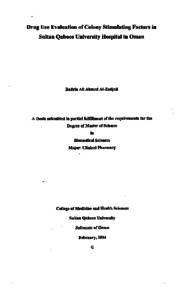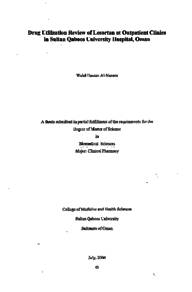Document
Drug use evaluation of colony stimulating factors in Sultan Qaboos University Hospital in Oman
Publisher
Sultan Qaboos University
Gregorian
2004
Language
English
English abstract
ABSTRACT Introduction: A major dose limiting side effect of cytotoxic chemotherapy is myelosuppression resulting in neutropenia. In current practice, the average length of hospitalization for neutropenia can exceed 1 week. Filgrastim and molgramostim, colony stimulating factors (CSFs), have been found to be effective in the treatment and prevention of neutropenia. The potential use of these agents in a wide range of conditions and their high cost necessitate that their efficacy and cost effectiveness are carefully considered by prescribers, pharmacists and health administrators. CSFs account for about 5% (R.O. 100,000; USD 250,000) of the total annual pharmacy budget at Sultan Qaboos University Hospital (SQUH). Aim: To conduct a drug use evaluation (DUE) to assess the appropriateness of filgrastim and molgramostim use in SQUH. Method: The prospective study was conducted over 9 weeks from May 31st to Augusts 1st 2003. The study included all patients on filgrastim or/and molgramostim. In-patients were identified from the pharmacy drug supply record. book, daily ward rounds and clinical pharmacists. Outpatients were identified by screening the prescriptions received in the pharmacy department. Each course of CSF was considered as a separate case. DUE criteria were developed for CSFs. Each filgrastim/ molgramostim course was classified as appropriate or inappropriate for the following main areas of the criteria; indication, dosage regimen and duration of therapy. Any course considered inappropriate for indication was not considered in the two other areas. The evaluation also included other areas such as occurrence of adverse drug reactions (ADRs) and cost factors. Data collection and data analysis was conducted by a pharmacist. All data was entered onto computer using SPSS for windows and analyzed using descriptive statistics. Results: A total of 44 patients were reviewed for the use of CSF, of whom 40 were adults and 4 pediatrics. The total number of courses reviewed was 91. Fifty-six courses (62%) were given for in patients and 35 courses (38%) for outpatients. Thirty six cases (40%) were on filgrastim and 55 (60%) on molgramostim. Sixty-six courses (73%) had appropriate indications. The remaining 25 courses (27%) used for inappropriate indications as follows; 10 courses (11%) to increase neutrophil count, 6 courses (7%) to maintain the administration of chemotherapy doses on a specific planned schedule, 6 courses (7%) to shorten neutropenia in <55 years old AML patients and 3 courses (3%) for the management of mucositis (used as a mouthwash) although the last 2 indications deem promising. A total of 66 cases were evaluated for the appropriateness of the dosage. The CSF was dosed appropriately in 61 cases (92%). The remaining 5 cases (8%) were under dosed. In all the cases with appropriate indications, CSF was given subcutaneously. In 62 cases (94%) CSF was given as single daily dose. The duration of therapy was appropriate in 53 cases (80%). Ten cases (11%) developed ADRs due to CSF therapy. Nine cases developed ADRs while on GM-CSF with bone pain being the most frequent adverse drug reaction reported. All ADRs were mild and managed symptomatically. A total of 622 vials of both filgrastim and molgramostim were given to the 91 cases, at a total cost of O.R. 24,821 (USD 62,052). Thirty five percent (R.O. 8735, USD 21,837) of the total cost were used for inappropriate and unapproved indications. Conclusion and recommendations: Rational use of high cost drugs such as CSF is important in any hospital. Most of the inappropriate use of CSF was for indications not specified in the criteria although some of them deem promising. Restricting CSF to only approved indications and prescribing appropriate dosage regimens may result in cost savings. All health care professionals should ensure that explicit guidelines are in place before such expensive drugs are included in the hospital drug formulary and regularly monitor and update such guidelines.
Member of
Resource URL
Arabic abstract
الملخص المقدمة : يعتبر تدهور نخاع العظم من أهم الآثار الجانبية المقيدة للجرعة في العلاج الكيماوي والذي يتسبب في نقص كريات الدم البيضاء الأكولة. قد وجد أن فيلجراستيم ( G - CSF) و مولجراموستيم ( GM - CSF ) وهي عوامل محفزة لخلايا النخاع , من الأدوية الفعالة في علاج ومنع نقص كريات الدم البيضاء الأكولة. أن استخدام هذه الأدوية في تشكيلة واسعة من الحالات وتكلفتها العالية يحتم على الأطباء والصيادلة ومدراء الصحة أن ياخذوا في عين الاعتبار فاعليتها وتكلفتها الباهظة حيث تمثل تكلفتها حوالي 5 %(ريال عماني ۱۰۰ ، ۰۰۰ , دولار امريكي ۲۰۰ ، ۰۰۰ ) من الميزانية السنوية الكلية للصيدلية في مستشفى جامعة السلطان قابوس. هدف الدراسة : إجراء تقييم لطريقة استخدام فيلجراستيم و مولجراموستيم في مستشفى جامعة السلطان القابوس. الطريقة أجريت الدراسة طوال 4 أسابيع من 31 مايو الى 1 أغسطس عام ۲۰۰۳ باستخدام التصميم المرتقب. تضمنت الدراسة جميع المرضى الذين تم اعطائهم فيلجراستيم أو / و مولجراموستيم. تم معرفة المرضى المنومين من سجل الصيدلية لمخزون الدواء ودورات الأجنحة اليومية ومن الصيادلة السريريين. أما بالنسبة للمرضى المراجعين في العيادات الخارجية فقد تم معرفتهم عن طريق فحص الوصفات الطبية المتلقاة في قسم الصيدلة. كل حالة فيلجراستيم أو مولجراموستيم صفت كحالة مناسبة أو غير مناسبة للفئات الرئيسية التالية: سبب الاستخدام نظام الجرعة ومدة العلاج. إذا اعتبر سبب الاستخدام لأي حالة غير مناسب, فان الحالة لم تقيم في الفئتين الآخرين. تضمن التقييم فئات أخرى أيضا مثل حدوث أعراض جانبية وعوامل التكلفة. أجري. جمع و تحليل البيانات من قبل صيدلي. جميع البيانات أدخلت على الكمبيوتر باستخدام Spss for windows وتم تحليلها باستخدام الإحصاء الوصفي. نتائج الدراسة : تم دراسة 44 مريضا من بينهم 40 بالا و 4 اطفال. كان إجمالي الجرعات العلاجية المدروسة 91 حالة. اعطي العلاج ل 56 (۹۲ %) حالة كمرضى منومين و ۳۰ حالة(۳۸ %) كمرضی مراجعين. كانت ۳۹ حالة( 40 %) على فيلجراستيم و55 (60 %) على مولجراموستيم. كانت اسباب الاستخدام مناسبة في 66 حالة( ۷۳ %). أما بالنسبة للحالات المتبقية (۲۷ %), كانت أسباب الاستخدام غير مناسبة وكما يلي: ۱۰ حالات (۱۱ %) لزيادة كريات الدم البيضاء الأكولة, 6 حالات (7 %) للحفاظ على إعطاء جرعات العلاج الكيماوي في الموعد المخطط , 6 حالات (۷ %) لتقصير مدة نقص كريات الدم البيضاء الأكولة في مرضى سرطان الدم الغير اليمفاوي الحاد البالغون من العمر 55 سنة و 3 حالات (۳%) لعلاج التهابات الفم (يستخدم كغسول للفم) بالرغم من أن بعض الدراسات اثبتت فعالية هذة الأدوية في علاج التهابات الفم مجموع الحالات التي قيمت لملاءمة الجرعة هي 66 حالة. كمية الجرعات العلاجية الموصوفة كانت مناسبة في 61 حالة(۹۲ %). كانت مدة العلاج مناسبة في 53 حالة(۸۰%). عشرة حالات (۱۱ %) تعرضت لاثار جانبية. تسع حالات منها تعرضت لاثار جانبية أثناء العلاج بالمولجراموستيم وكانت الام العظام من الاثار الجانبية الأكثر تكررا. كانت تكلفة زجاجات الفياجراستيم و المولجراموستيم المستخدمة في 91 حالة هي ۲۸۱، ۲۶ ریال عماني ( ۹۲ ، ۰۰۲ دولار أمريكي). خمسة و ثلاثون في المئة (۸۷۳۵ ريال عماني, ۲۱ ، ۸۳۷ دولار امريكي) من التكلفة الإجمالية أستخيم لاسباب غير مناسبة ولم تثبت بعد الخلاصة والمقترحات : الاستعمال المقنن للادوية ذات التكلفة العالية مهم في أي مستشفي. بينت الدراسة بان معظم أسباب الاستخدام الغير مناسبة للعلاج لم تذكر في معلومات المنتج المعتمد و / أو توجيهات الجمعية الأمريكية العلم الأورام السريرية بالرغم من أن بعض تلك الاستخدامات تعتبر مرجوه. الحد من استخدام الفيلجراستيم او المولجراموستيم للحالات والأسباب التي ثبتت فقط و تحديد نظم الجرعة المناسبة قد ينتج في اتخار التكاليف. ينبغي على جميع أعضاء الرعاية الصحية أن يضمنوا وجود توجيهات واضحة قبل أن تدخل هذه الأدوية الباهضة الثمن في قائمة ادوية المستشفى وايضا عليهم القيام بمتابعة و تحديث مثل هذه التوجيهات دوريا.
Category
Theses and Dissertations


